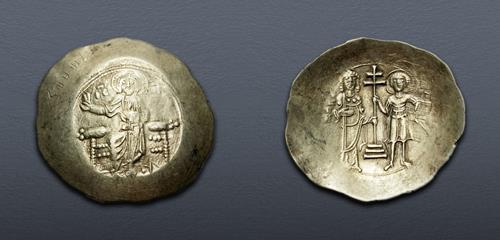|
John II Comnenus. 1118-1143. EL Aspron Trachy Nomisma (30.5mm, 4.32 g, 6h). Constantinople mint. Struck 1122-circa 1143. Christ Pantokrator enthroned facing; triangle of pellets at each end of cushion on throne / Crowned facing figure of John, wearing chlamys and resting hand on chest, and St. George, wearing military attire and holding sword, both holding long patriarchal cross set on three steps between them. DOC 8c; SB 1942. Toned, minor scratches, graffiti (including clear “Masach” in Armenian on the obverse). Good VF.
Ex Classical Numismatic Group Electronic Auction 310 (4 September 2013), lot 469.
The clear Armenian graffiti on the obverse of this coin depicting Christ appears to be a transliteration of the Hebrew word “Masach.” Masach is concept that features in Kabbalah (a form of Jewish mysticism). In Kabbalah, the Masach is a type of screen or veil that prevents the overpowering light that emanates from above from destroying the weaker vessel that seeks to draw near to the light. Some Biblical examples of this concept include Moses’ veil in Exodus 34, and the Parochet that separated the Holy of Holies in the Tabernacle and the Temple. In Exodus 34, Moses’ face shone brightly after spending time with God atop Mount Sinai. The overpowering light that emanated from his face frightened the people and so, Moses wore a veil before the congregation. Likewise, the Parochet, the great curtain that separated the Holy of Holies, acted as a physical barrier between God’s presence and the people. Eventually, the curtain was rent from top to bottom upon Christ’s death as recounted in Matthew 27: 51. For, upon Christ’s death, the state of separation that existed between God and man was made rectifiable through Christ’s sacrifice. In this way the ultimate Masach, or screen, between God and man was removed.
This coin offers a fascinating intersection between Armenian Christianity and Jewish Kabbalah. What motivated the person who applied this graffiti to this coin depicting Christ is unknowable, but the connections between these ways of thinking are interesting to consider.
Closing Date and Time: 5 June 2024 at 15:43:00 ET.
All winning bids are subject to a 20% buyer’s fee.
|
